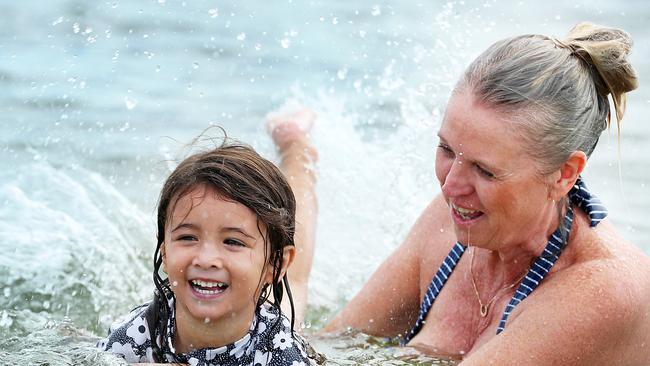Queensland weather: Extreme heatwave brings temperatures 10C above average
Temperature records have been smashed in parts of Queensland as much of the Sunshine State cracked 40C. SEE TEMPS
QLD News
Don't miss out on the headlines from QLD News. Followed categories will be added to My News.
Temperature records have been smashed in parts of Queensland as the Sunshine State continues to swelter through a “very brief” heatwave.
Bureau of Meteorology meteorologist Shane Kennedy said Bundaberg hit a maximum of 38.6C, which was the highest February maximum since record keeping in the area began 42 years ago.

Gladstone Airport broke its 28-year February maximum record with a top of 38.7C.
Samuel Hill, north of Yeppoon, set a new record with 38.2C and St Lawrence, north of Rockhampton, broke its 17-year record with a top of 39.5C.
“Rockhampton was 41.1C … which was the equal hottest it’s been in just over 50 years in February,” Mr Kennedy said.
The hottest place in Queensland today was Birdsville where temperatures reached 43.2C.
In the southeast, Gatton hit a maximum of 40.4C.
Ipswich was about 6C above average with a top of 37.1C and Brisbane city was about 4C above average as the mercury hit 34C.
Mr Kennedy said the heatwave will be less severe across the state tomorrow and will ease from late Tuesday or Wednesday morning.
“It will still be quite hot on Tuesday, not quite as bad as today which was the peak, but still above average,” he said.
“In the city (it will be) about two to five degrees above average.
Mr Kennedy said the heatwave would be “very brief” with below average temperatures expected from Wednesday.
“We should finally see some relief on Wednesday. We’ll see a cooler change to push through later tomorrow sort of afternoon evening.
“It should be a return to showery conditions late on Tuesday into Wednesday for the southeast and it’ll be back below average for the southeast.”

Earlier
Extreme heatwave conditions are expected to hit parts of the state today, with temperatures as much as 10C above average.
Locally extreme heatwaves are set to impact the Capricornia region today, with hot conditions expected to span across the entire lower half of the state.
Are you ready for #Heatwave conditions? Things look set to heat up through large parts of the state over the coming days - so be prepared, and stay cool and hydrated. Queensland forecast and weather warnings here: https://t.co/NGlKjAnlay pic.twitter.com/7smImZATKr
— Bureau of Meteorology, Queensland (@BOM_Qld) February 20, 2021
Bureau of Meteorology’s Rosa Hoff said the extreme temperatures would be localised.
“We’re actually going to have a severe heatwave for parts of central Queensland peaking at locally extreme,” she said.
“Temperatures are going to be as much as 10C above average in Capricornia where we do have those locally extreme heatwave conditions.”
Rockhampton will see temperatures rise to 43C, while Emerald and Isisford will reach 41C.
“The severe heatwave region is for parts of Capricornia, Wide Bay, Burnett and the Central Highlands and Caulfields where they’re going to be six to nine degrees above average.”
She said across the southeast and parts of central Queensland were experiencing low intensity heatwave conditions, with temperatures six to nine degrees above average.
The hot temperatures were being caused by warm air that has pushed through from the west, raising temperatures.
Warm conditions are expected to continue through until Wednesday.
“Today is really the peak of the heat in terms of temperatures but for many locations tomorrow will still be fairly warm.”
Meanwhile, pet owners have been urged to look out for their furry best friends during the heatwave.
Former Department of Agriculture chief veterinary officer Ron Glanville said it was typical to see a spike in heat stress cases at vets during heatwaves.
“They can easily overheat, so people need to be aware of what they need to do to keep them safe,” Mr Glanville said.
“It means you’ve just got to be more careful with your pets,” he said.
Top tips Mr Glanville gave included making sure outdoor dogs had a cool, shaded place to sleep and plenty of water, and weren’t left on hot bitumen during the day.
“They can get dehydrated if you’re not careful,” he said.
Mr Glanville said these sorts of hot conditions, which were becoming more frequent due to climate shifts, also had impacts on native animals.
“Certainly we see more cases of suffering from heat in these situations,” he said.
Anyone who comes across distressed native animals should contact a local wildlife hospital.
CURRENT TEMPS & 7-DAY FORECASTS


